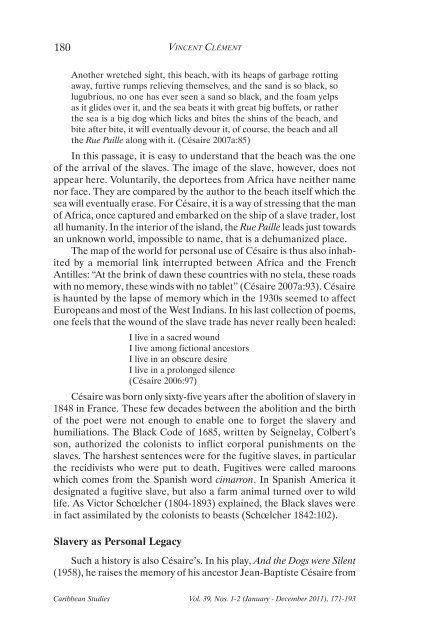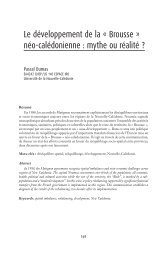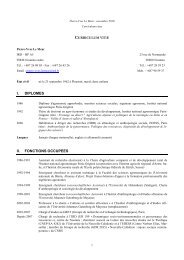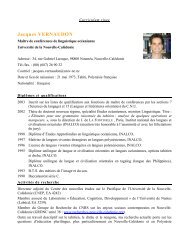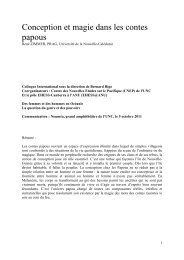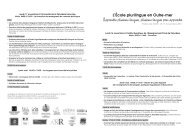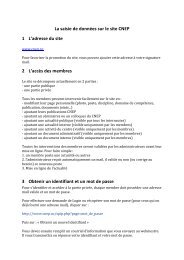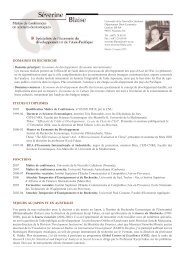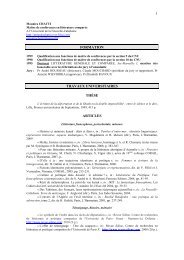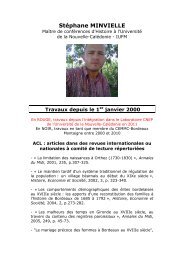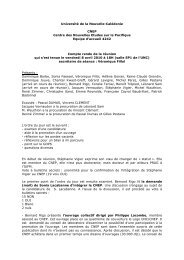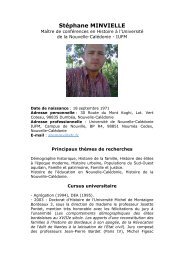LATITUDE AND LONgITUDE Of THE PAST - Centre des Nouvelles ...
LATITUDE AND LONgITUDE Of THE PAST - Centre des Nouvelles ...
LATITUDE AND LONgITUDE Of THE PAST - Centre des Nouvelles ...
Create successful ePaper yourself
Turn your PDF publications into a flip-book with our unique Google optimized e-Paper software.
180Vincent ClémentAnother wretched sight, this beach, with its heaps of garbage rottingaway, furtive rumps relieving themselves, and the sand is so black, solugubrious, no one has ever seen a sand so black, and the foam yelpsas it gli<strong>des</strong> over it, and the sea beats it with great big buffets, or ratherthe sea is a big dog which licks and bites the shins of the beach, andbite after bite, it will eventually devour it, of course, the beach and allthe Rue Paille along with it. (Césaire 2007a:85)In this passage, it is easy to understand that the beach was the oneof the arrival of the slaves. The image of the slave, however, does notappear here. Voluntarily, the deportees from Africa have neither namenor face. They are compared by the author to the beach itself which thesea will eventually erase. For Césaire, it is a way of stressing that the manof Africa, once captured and embarked on the ship of a slave trader, lostall humanity. In the interior of the island, the Rue Paille leads just towardsan unknown world, impossible to name, that is a dehumanized place.The map of the world for personal use of Césaire is thus also inhabitedby a memorial link interrupted between Africa and the FrenchAntilles: “At the brink of dawn these countries with no stela, these roadswith no memory, these winds with no tablet” (Césaire 2007a:93). Césaireis haunted by the lapse of memory which in the 1930s seemed to affectEuropeans and most of the West Indians. In his last collection of poems,one feels that the wound of the slave trade has never really been healed:I live in a sacred woundI live among fictional ancestorsI live in an obscure <strong>des</strong>ireI live in a prolonged silence(Césaire 2006:97)Césaire was born only sixty-five years after the abolition of slavery in1848 in France. These few deca<strong>des</strong> between the abolition and the birthof the poet were not enough to enable one to forget the slavery andhumiliations. The Black Code of 1685, written by Seignelay, Colbert’sson, authorized the colonists to inflict corporal punishments on theslaves. The harshest sentences were for the fugitive slaves, in particularthe recidivists who were put to death. Fugitives were called maroonswhich comes from the Spanish word cimarron. In Spanish America it<strong>des</strong>ignated a fugitive slave, but also a farm animal turned over to wildlife. As Victor Schœlcher (1804-1893) explained, the Black slaves werein fact assimilated by the colonists to beasts (Schœlcher 1842:102).Slavery as Personal LegacySuch a history is also Césaire’s. In his play, And the Dogs were Silent(1958), he raises the memory of his ancestor Jean-Baptiste Césaire fromCaribbean Studies Vol. 39, Nos. 1-2 (January - December 2011), 171-193


